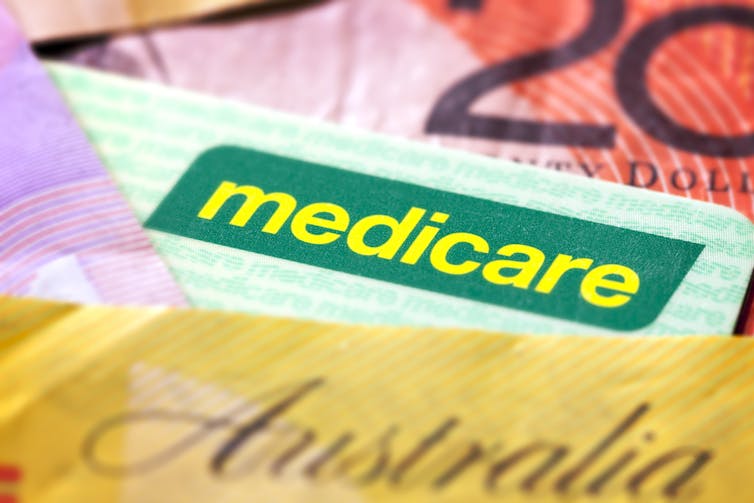
Being able to afford health care is a pressing issue for many Australians. And encouraging GPs to bulk bill is one measure the government is taking to ease the strain.
So what would it take for GPs to bulk bill everyone? In our recent paper, we calculated this is possible and affordable, given the current health budget.
But we show recent incentives for GPs to bulk bill aren’t enough to get us there.
Instead, we need to adjust health policies to increase bulk-billing rates and to make our health system more sustainable.
How do the incentives work?
In recent years, the government has introduced various incentives to try and encourage GPs to bulk bill (so patients pay nothing out-of-pocket).
The most recent has been the “triple bulk-billing incentives” or “triple bonus” for short. These have been in place since November 2023.
Under these incentives, GPs in metropolitan areas are paid a A$20.65 bonus if they bulk bill concession card holders or children under 16 years. GPs in rural and remote areas are paid $31.35-$39.65 extra. These bonus payments are in addition to regular Medicare rebates GPs receive.
But when we looked at whether these latest incentives are likely to work to boost bulk billing, we found a city-country divide.

City GPs may not be convinced
We worked out the triple bonus will not help most people in metropolitan areas.
That’s because in these areas the bonus is much lower than what patients currently pay out-of-pocket. In other words, if GPs did bulk bill these groups, their income would be lower than what they could have charged. So the bonus wouldn’t be enough incentive for them to bulk bill.
For example, we found in greater Melbourne, the average out-of-pocket costs for a non-bulk billed GP visit is about $30-$56 depending on the suburb. This is much higher than the $20.65 triple bonus amount in metropolitan regions. We see similar patterns across all metropolitan areas.
But country GPs may be swayed
The picture is different in rural and remote areas. Here, the average out-of-pocket cost for a non-bulk billed GP visit varies substantially – around $28-52 in rural regions and $32-123 in remote areas. The highest cost on the mainland was $79 but GP visits on Lord Howe Island were the most expensive overall, at $123.
For patients living in areas where their actual payment is less than the bonus amount, the incentive does help. In other words, it would be financially advantageous for GPs to bulk bill these patients, but not where the out-of-pocket costs are higher than the bonus.
Our online map shows where GPs are most likely to bulk bill. The map below shows how out-of-pocket costs vary around Australia.
How about bulk billing for all?
The picture is a little more complex when we start talking about bulk billing all GP visits – regardless of location or patients’ concession card status.
We worked out this would cost about $950 million a year for all GP services, or $700 million a year for face-to-face GP consultations.
This is within reach under the current budget, especially for face-to-face GP consultations.
The government has earmarked $3.5 billion over five years for the “triple bonus” incentives. That’s $700 million a year.

We can afford to, but should we?
Introducing free GP visits for all would require careful consideration, as it would encourage more GP visits.
This might be a good thing, particularly if people had previously skipped beneficial care due to high costs. However, it may encourage more people to see their GP unnecessarily, taking away limited resources from those who really need them. This could ultimately increase wait times for everyone.
So providing free GP visits for all may not be efficient or sustainable, even if it’s within the budget.
But paying more than $50 for a GP visit, as many do, seems too expensive and also makes the health-care system less efficient.
That’s because primary care is often considered high-value and preventive care. So if people can’t afford to go to the GP, it can lead to more expensive hospital and emergency room costs down the track.
So we need to strike a balance to make primary care more affordable and sustainable.
How do we strike a balance?
One, concession card holders and children should get free primary care regardless of where they live. This would allow more equitable care to populations who need health care the most. Bulk bulling children is a long-term investment, which may delay onset of diseases, and prevent intergenerational poverty and poor health.
Two, the government could also provide free primary care to all people in rural and remote areas. It can do this by lowering the triple bonus to match what GPs currently charge. Over time, GPs and the government can evaluate and negotiate fair prices for GPs to charge. This can be adjusted in line with inflation and other measures.
Three, the government can increase Medicare rebates (the amount Medicare pays a doctor for a GP visit) so patients not covered above only pay about $20-30 a visit. We consider this an affordable amount that will not result in more use of primary care than necessary.
Four, the government can design a policy to reduce unnecessary GP visits that take away limited GP time from high-need patients. For example, patients currently need to see GPs to get referral letters although they already have an established specialist for their ongoing chronic conditions.
Five, the government can provide GPs funding needed to improve patient outcomes and reward GPs who provide high-quality preventive care. The current fee-for-service funding model hurts good doctors who keep their patients healthy because doctors are not paid if their patients do not come back.
Yuting Zhang has received funding from the Australian Research Council (future fellowship project ID FT200100630), Department of Veterans' Affairs, the Victorian Department of Health, and National Health and Medical Research Council. In the past, Professor Zhang has received funding from several US institutes including the US National Institutes of Health, Commonwealth fund, Agency for Healthcare Research and Quality, and Robert Wood Johnson Foundation. She has not received funding from for-profit industry including the private health insurance industry.
Karinna Saxby has previously received funding from the department of health and aged care.
This article was originally published on The Conversation. Read the original article.







